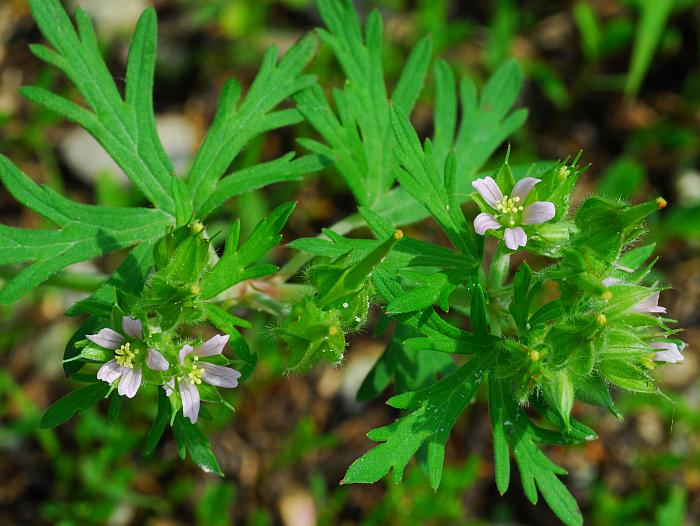Geranium carolinianum L.
Carolina Crane's Bill

Native
CC = 0
CW = 5
MOC = 68
© SRTurner
Geranium carolinianum L.Carolina Crane's Bill | |
 |
Native CC = 0 CW = 5 MOC = 68 |
© SRTurner |
|
Family - Geraniaceae Habit - Annual forb, usually from a large taproot. Stems - Loosely ascending to erect, to 65 cm, often reddish, widely branching, moderately pubescent with short to long (0.2-1.0 mm), spreading to somewhat downward-pointing, mostly nonglandular hairs, usually with some glandular hairs toward the tip.
Leaves - Basal and alternate, stipulate, the basal leaves long-petiolate, those of the stems with progressively shorter petioles. Stipules to 1 cm long, 3 mm broad at the base, ciliate at least on one margin, often pinkish. Blades 1-7 cm long, wider than long to about as long as wide, kidney-shaped to nearly circular in outline, deeply palmately 5-9-lobed, the lobes more or less obovate, mostly deeply and sharply 3-or 5-lobed, sometimes with additional lobes and/or teeth along the margin, the surfaces sparsely to densely pubescent with more or less appressed nonglandular hairs.
Inflorescence - Axillary and often also terminal, short-to long-stalked, pairs of flowers, these sometimes condensed into small clusters. Individual flower stalks 3-11 mm long, 0.5-1.1 times as long as the sepals, pubescent with spreading, mostly gland-tipped hairs. Peduncle expanding to 5 cm in fruit, densely pubescent. Pedicels to 1 cm long in fruit, densely pubescent, subtended by ciliate subulate bracts.
Flowers - Sepals 5, 5-6.5 mm long, becoming enlarged to 11 mm at fruiting, ovate, tapered or narrowed to a conspicuous, short, awnlike extension 1.5-2.0 mm long at the tip, pubescent with short to long, loosely ascending, glandular and nonglandular hairs. Petals 5, 5.5-7.0 mm long, obtriangular, truncate to shallowly notched at the tip, pale pink or pale lavender to nearly white. Stamens 10, erect, surrounding the ovary. Staminodes absent. Filaments compressed and expanded at the base, green to pinkish, ciliate. Ovary superior, densely long ciliate, 5-carpellate. Carpels green, ovoid. Styles 5, green, glabrous at the apex, united at the base.
Fruits - Mericarps 19-25 mm long at maturity, the seed-containing basal portion 3.0-4.5 mm long, the lateral surfaces smooth, pubescent with relatively long (0.7-1.5 mm) upward-pointing hairs (these mostly or all nonglandular), lacking a dorsal ridge or wing, the stylar beak with spreading to loosely ascending, all or mostly nonglandular hairs, the slender extension between the columnar portion and the stigmas 1-2 mm long. Seeds 2.0-2.2 mm long, the surface appearing smooth or with a faint fine network of ridges and pits.
Flowering - May - July. Habitat - Glades, bluffs, prairies, forests, fields, pastures, roadsides, railroads, open disturbed areas. Origin - Native to the U.S. Lookalikes - G. pusillum, G. columbinum, G. molle. Other info. - This somewhat weedy species is common throughout most of Missouri, and occurs to at least some extent across the entire continental U.S. The plant is identified by its palmately lobed leaves and small, pink flowers. Each sepal has a small but distinctive projection, which serves to distinguish this species from some of its lookalikes. The individual flower stalks are short, less than twice as long as the sepals. This is probably the most abundant Geranium in Missouri. Photographs taken along Hwy 29 near Greensboro, NC., 4-20-03 (DETenaglia); also near Labadie, Franklin County, MO, 5-26-2013, at Klondike County Park, St. Charles County, MO, 5-15-2014, and Riverfront Park, Washington, Franklin County, MO, 5-28-2020 (SRTurner). |